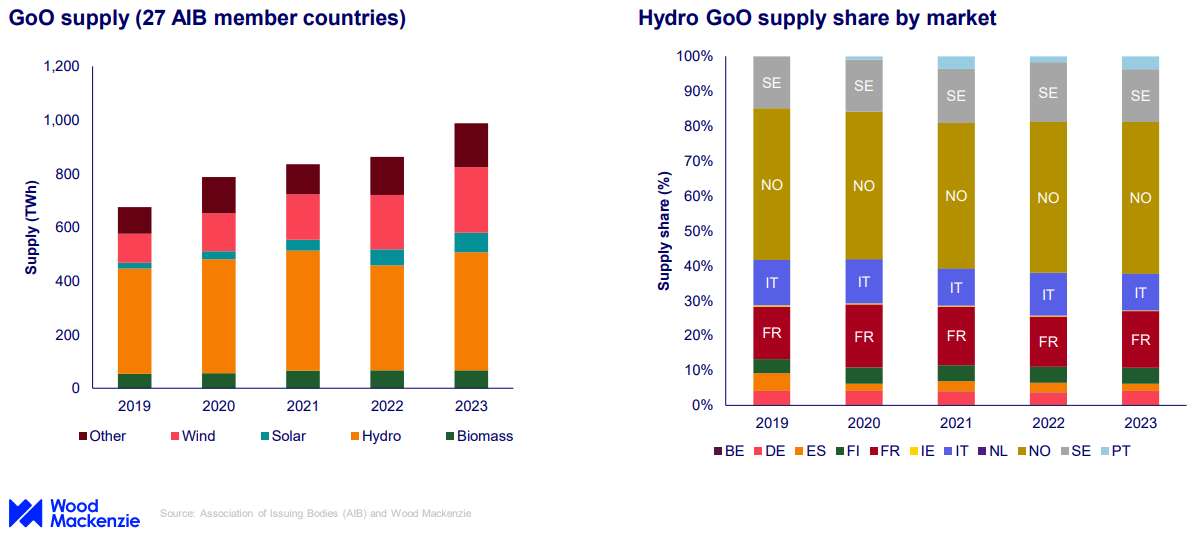Book and claim - Part 1
Energy Attribute Certificates play a vital but controversial role in the energy transition
Welcome to Carbon Risk — helping investors navigate 'The Currency of Decarbonisation'! 🏭
If you haven’t already subscribed please click on the link below, or try a 7-day free trial giving you full access. By subscribing you’ll join more than 4,000 people who already read Carbon Risk. Check out what other subscribers are saying.
You can also follow my posts on LinkedIn. The Carbon Risk referral program means you get rewarded for sharing the articles. Once you’ve read this article be sure to check out the table of contents [Start here].
Thanks for reading Carbon Risk and sharing my work! 🔥
Estimated reading time ~ 13 mins

Known as Guarantees of Origin (GOs) in Europe, or Renewable Energy Certificates (RECs) in North America, Energy Attribute Certificates (EACs) document that one MWh of electricity has been generated and supplied (net) to the grid, through a specified renewable energy resource.1
EACs are based on a “book and claim” chain of custody market mechanism. They enable suppliers of low-carbon solutions to “book” the environmental attributes of a good they have produced (power generated via renewables, emission savings, etc), and for users to “claim” those same attributes.
Importantly, the trade can happen even if there is no actual physical exchange of renewable electricity between the buyer and seller. EACs are useful because they enable a trade to occur that, in their absence, would be very difficult to achieve. Once an electron joins the grid it is impossible to distinguish power generated using renewables from any other electrons. The custody model assumes that one unit of environmental attribute is equal to another, wherever it is produced or consumed. One electron equals another electron, one tonne of CO2 avoided equals another tonne of CO2, and so on.
Each certificate is unique, and its attributes include independently verified claims rights, documents of origin, and audit trails of renewable energy generation. These certificates can also be traded discreetly from the underlying power (i.e., unbundled), or can be sold together with the physical electricity (i.e., bundled, typically as part of a Power Purchase Agreement). The holder owns the legally recognised property rights to the underlying environmental attributes. The certificate can be retired (also referred as ‘cancelled’) by, or on behalf of its owner to claim usage of the environmental attributes.
GO prices whipsawed by weather and political sentiment
The Guarantees of Origin (GO) market was introduced in 2001 as part of the EU’s first Renewable Energy Directive (RED I). The GO market began life as a traceability mechanism, existing to provide proof that electricity consumed was generated using renewable energy. The GO market operates without borders within the EU and European Economic Area (EEA) and currently covers around one-third of total European power demand.
Historically oversupplied, the price of GO certificates has typically traded below €1 per MWh. A drop in hydropower output in 2022, coupled with an increase in demand for GOs resulted in GO prices spiking towards €10 per MWh. The price spike was violent, albeit brief. By early 2024 an increase in renewable energy generation, more favourable weather conditions, and weaker power demand marked a return to over-supplied conditions and significantly lower GO prices.
Hydropower accounts for the majority (60%) of GOs issued in Europe, with Norway delivering around half of the hydro GO supply. The share of hydro-based GOs is expected to drop to 35% by 2030, as more non-hydro renewables come onstream elsewhere in Europe and begin issuing GOs. Warmer and increasingly volatile weather patterns have contributed to GO price volatility, but this should dampen as the share of non-hydro generation increases.
Political factors can also contribute to market volatility. For example, the UK’s exit from the EU meant that it ceased to recognise EU GOs. The UK had been a net importer of GOs, and so the ban contributed to the surplus within the EU, and the pressure for lower prices. Meanwhile, Norway threatened to pull out of the GO market when the Labour-led government came to power in 2021. In recent weeks they have since pulled back from that position, stating that they are no longer opposed to remaining in the GO market. If they had pulled out it would have generated a severe shortage.
Demand for GOs set to surge as mandatory emissions reporting begins
The Corporate Sustainability Reporting Directive (CSRD) entered into force at the beginning of 2024. It will require all companies operating within the EU, and non-EU companies that do business in Europe, to disclose information on sustainability risks and the impact of their activities on the environment (see Full disclosure).
The European Sustainability Reporting Standards (ESRS), complementary rules under the CSRD, mandates that companies must use contractual instruments such as GO certificates to claim renewable energy consumption. Simply being located in a country with very high renewable energy generation is not sufficient.
Companies can also use the instruments to report their carbon intensity of production. When disclosing market-based emissions, the ESRS indicates that businesses can report “emissions linked to purchased electricity bundled with instruments such as Guarantees of Origin or Renewable Energy Certificates.”
High prices required to pass the additionality test
Academic research suggests that EAC’s have been non-additional in nature, i.e., renewable energy generation and emission reductions would have occurred in the absence of the EACs. Part of this is a function of their historically low prices, which in turn is a consequence of their original function as a tracing mechanism. Other viewpoints suggests that although individual EACs fail the additionality test, the aggregation of all the EACs does provide a valuable signal of market demand.



